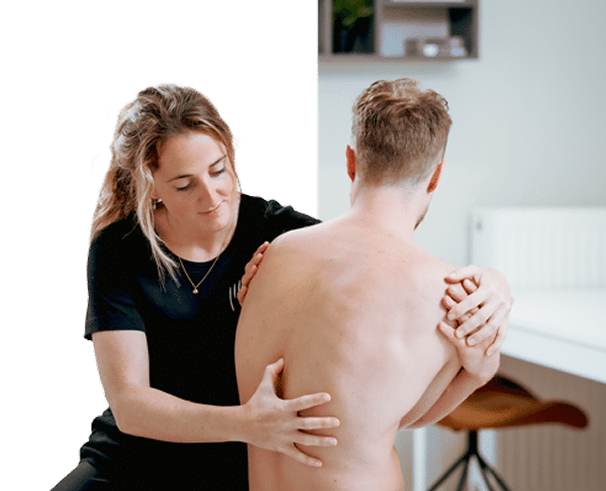What are biceps complaints
Biceps complaints describe pain or functional limitation in the biceps and the tendons at the front of the upper arm. The biceps bend the elbow, rotate the forearm, and support the shoulder during lifting. Pain can be located in the muscle itself or at the attachment to the forearm. Sometimes it radiates to the shoulder or elbow.
Symptoms
- Biceps pain when lifting, reaching, or doing push-ups
- Pain at the biceps attachment in the forearm when gripping or rotating
- Stiff feeling in the upper arm after rest or in the morning
- Loss of strength during curls and forearm rotation
- Grinding or clicking sensation at the front of the shoulder at the biceps groove
- Sudden pain with a visible bulge in the upper arm, also called the Popeye sign biceps
Causes
The most common cause is overuse. This occurs with frequent biceps exercises in the gym and heavy work. Rapid training build-up also plays a role. Insufficient control of the shoulder blade and trunk increases the pulling force on the tendon. With tendon irritation, we speak of biceps tendinopathy or biceps tendon inflammation. In rare cases, a tear in the tendon occurs, a biceps brachii tendon tear.
What you can do yourself
- Dose your load and keep moving without sharp pain
- Start workouts with gentle activation and finish with a short cool down
- Choose light curls with dumbbells or cables to stimulate blood flow
- Pay attention to posture and shoulder blade control during work and sports
- If the complaints persist, schedule an intake
Examination and treatment at De Fysio Man
We start with an intake and test the shoulder, elbow, and wrist. We determine whether the issue concerns the tendon in the groove, the attachment, or the muscle belly. You receive a plan with clear steps and measurable goals.
- Tendon-focused exercise therapy with progression from isometric to controlled strength work
- Mobilizations and technique advice for lifting, reaching, and sports movements
- Progressive strength with dumbbell bicep curl, barbell bicep curl, and bicep curl cable machine
- Variants such as trx bicep curl, lying biceps curl, and kettlebell biceps where appropriate
- Taping of the biceps for short-term comfort if useful
Sports and training
Continue training with smart adjustments. Biceps exercises in fitness and gym workouts remain possible if you reduce tempo and weight. Vary grips and angles. Chin-ups for biceps can be reintroduced once pulling forces are tolerated without pain. Superset biceps triceps may be added later in the program. Triceps and biceps work together. Biceps vs triceps is not a choice but a balance.
In bicep curls muscles worked, the focus is on the biceps and supination of the forearm. Build tension gradually and keep the wrist neutral.
Simple anatomy
The biceps have two heads. The long head, biceps caput longum, runs through the biceps groove at the front of the shoulder. The tendon attaches to the radius. This area is called the biceps brachii insertion. Do not confuse this with the biceps femoris in the thigh. With persistent complaints, a doctor may choose for a biceps tenotomy. Rehabilitation remains important afterward.
When immediate help is needed
A snapping sensation with immediate loss of strength. Rapid swelling or visible deformity. Inability to lift or rotate without sharp pain. Contact a specialist immediately.
Rehabilitation phases
Pain reduction
We reduce stimuli and keep you active with pain-free movements. You learn safe pain limits for work and sports.
Strength and control
We increase the load with biceps tendinopathy exercises. You receive guidelines for tempo, repetitions, and recovery per day.
Return to sport
We progress to functional pulling movements and later to chin-ups for biceps. Technique remains central. You return safely and confidently to your sport.
Prevention
- Build load gradually and vary exercises
- Maintain shoulder blade control and core strength
- Plan regular technique checks in the gym
Frequently asked questions
What is the difference between muscle soreness and biceps complaints
Muscle soreness subsides within a few days and feels diffuse. Biceps complaints cause sharper pain with specific movements or pressure on the tendon and return with load.
Can I continue training
Yes, if the pain remains mild and recovers quickly. Choose controlled variants such as cable or trx and increase gradually. Avoid explosive repetitions until the pain is consistently low.
When to suspect a tear
With a snapping sensation, immediate strength loss, and a bulge in the upper arm. This may indicate a biceps brachii tendon tear. Have this assessed quickly.
Does taping or a brace help
Taping or a brace can provide temporary comfort. The core of recovery is a well-structured exercise program with attention to technique and progression.
Share this article:


